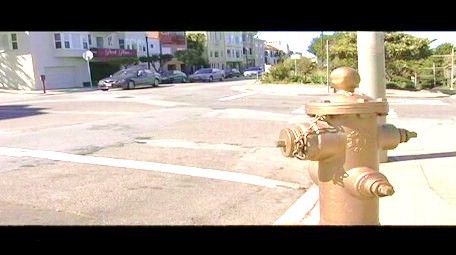
Or is it? Cassidy Friedman of the SF Appeal today takes a look at the myth behind the legend of the golden fire hydrant at 20th and Church, and asks the tough question: Did this little thing really save the whole Mission District?
Uncovering The Truth About The Mission’s Golden Fire Hydrant
Richard of Sparkletack addressed the complete story of Sparky almost four years ago. That man knows San Francisco, and he does exhaustive research as well.
In short: Sparky is a memorial, like statues of anonymous soldiers. Did that really need “uncovering”?
If you want to know about city history, Sparkletack is a really terrific resource.
from meave’s link, here is an interesting and plausible account:
Mike Smith, M.A.
September 19, 2007 at 3:44 pm
“The Fire raged for three days, April 18-20, and was deliberately & intentionally stopped across Dolores street from Mission Dolores by an ecumenical mass of 300 men who refilled their water wagons 10 times, pushing them south on Dolores then right onto steep 20th st.,then feathered the hand brake to roll back down to spray on the east side of Dolores across from “The Mish” as my then 21 year old grandfather Walter B. Smith called it. He & his brothers Arthur & Orde & their father Dr. Thomas Orde Lees Smith fought the fire hand to hand until it was stopped at that line of Dolores. The statue at Dolores & Market st. mentions it, I think.”
I’m guessing they filled up the wagons either in the Lagoon on Albion or from the creek running down 17th
Sparkletack is fantastic. Another great historical resource that lets me sound really smart is the Virtual Museum of San Francisco.
Linked is a report from the assistant superintendent of the Spring Valley Water Company, the primary water company of the time. Lots of detail for the infrastructure nerds out there, as well as some amazing descriptions of the city and the Mission after the quake.
Neo Displacer, the lagoon was filled in and the creek was buried in conduits during the 1870s. VMoSF also has reports from individual fire companies showing the cisterns and hydrants they used — the one from Chief Waters, Battalion 7/Engine 30, has lots of Mission references.
“I was notified that the fire was starting at Valencia St., so I ordered the companies to report at that place. I tried all the hydrants south on Valencia St. to 15th St., west on 15th to Guerrero St., north on Guerrero to Hermann and Buchanan streets. By connecting these engines, we held the fire from crossing Market St. with this one stream [ from Hermann and Buchanan]. Other engines arrived and I obtained another steam, and in this way we held the fire in check until I was notified that this block was going to be dynamited, and we were forced to leave. The work of the wreckers was not successful, as the block burned up after being dynamited.
We next diverted our attention in an effort to prevent the fire from crossing Guerrero St., and with the aid of these two streams succeeded in saving the entire block between Duboce and Clinton Park.
After this Engine No. 27 was ordered to 20th and Dolores streets, as I understood there was water there. Engine No. 27 was moved to 17th and Howard St. late Thursday afternoon. Engines No. 19-27-26 and 21 made their last stand at Dolores and 20th streets.”
Engine Company 7:
After a consultation between Battalion Chiefs McKittrick and Conlon I left for 20th and Church streets, with a wagon load of hose. I found water at this point, and also at 21st and Dolores streets. I then returned for two more loads of hose, and in connections with Engines No. 27 and 19 we had sufficient hose to fight the fire down the north side of 20th St. to Mission St., where the fire was extinguished on the morning of April 20th at about 10 a.m.
Our operations in this district were under the supervision of Battalion Chief Maxwell, and due to the fact that we were able to obtain a supply of water we were able to stop the fire from crossing 20th St., and destroying the complete Mission district.